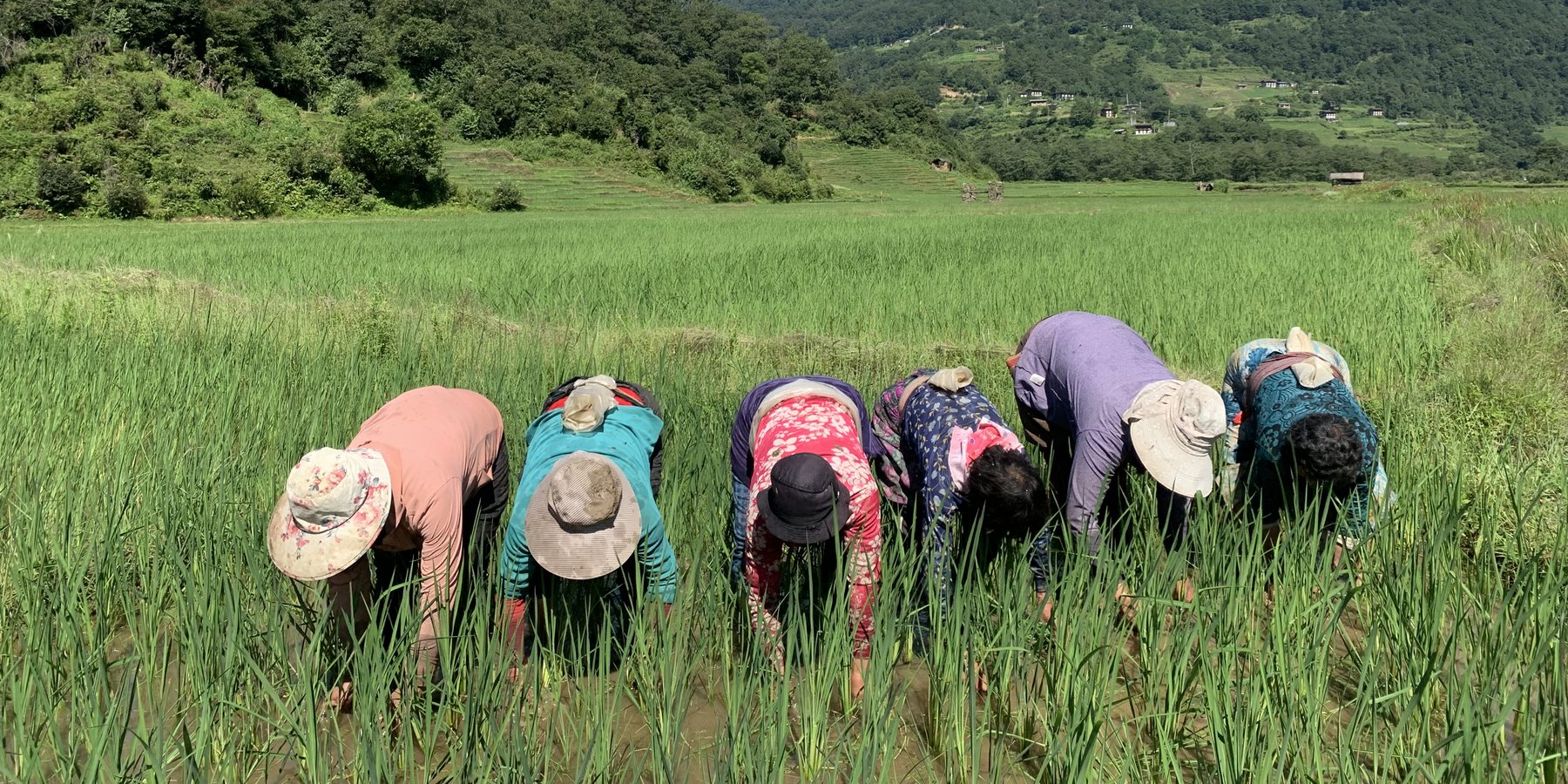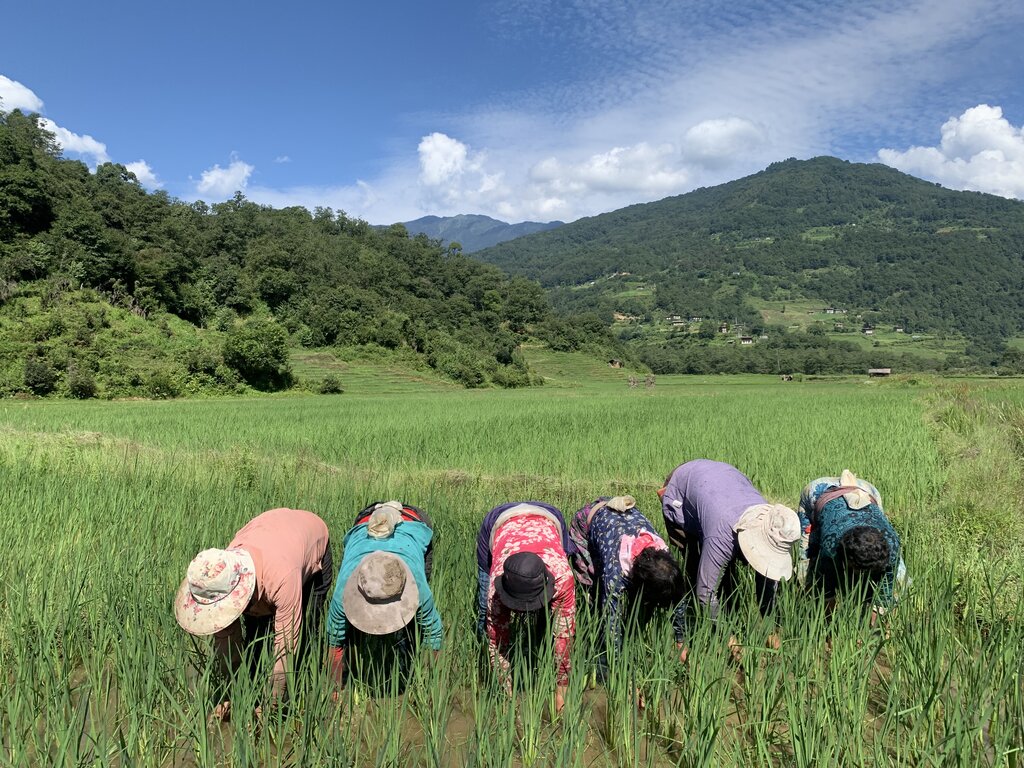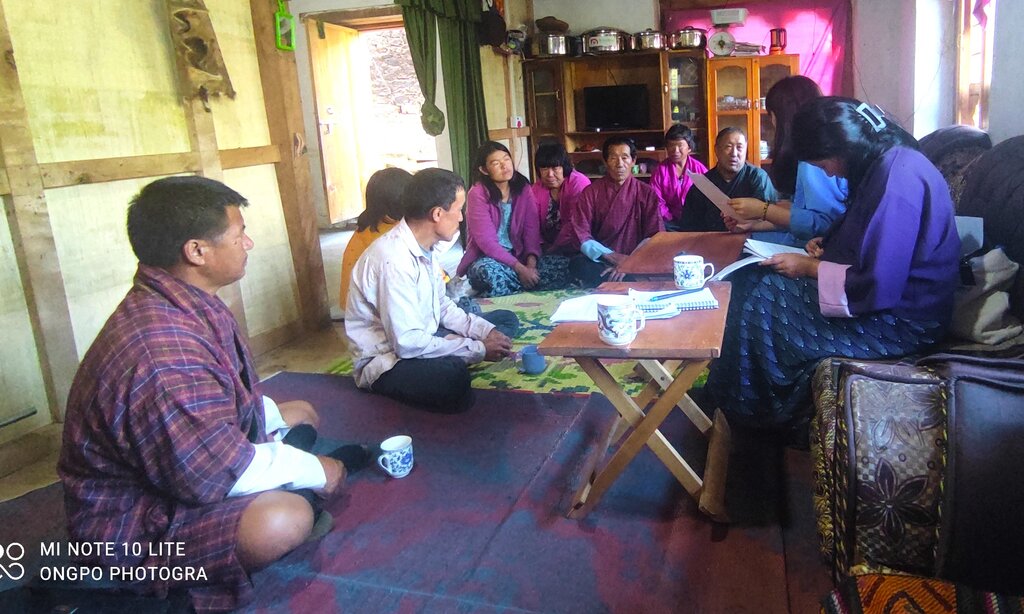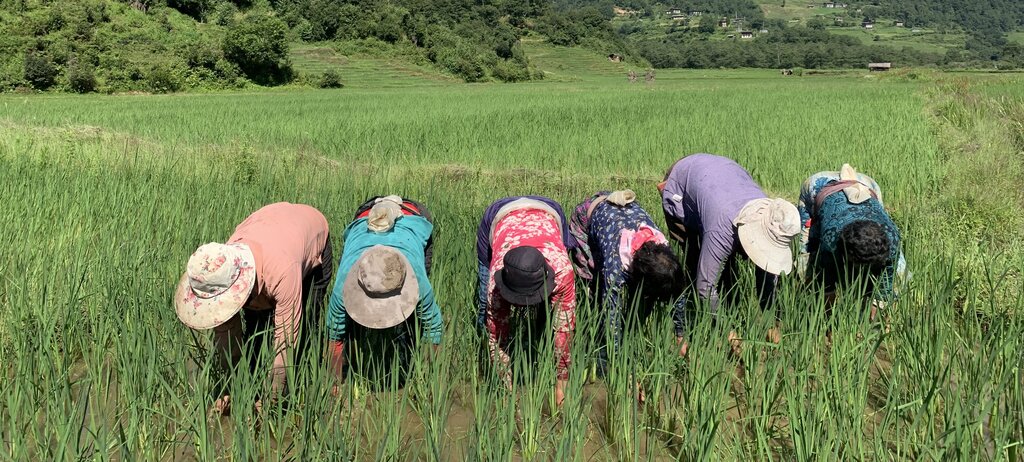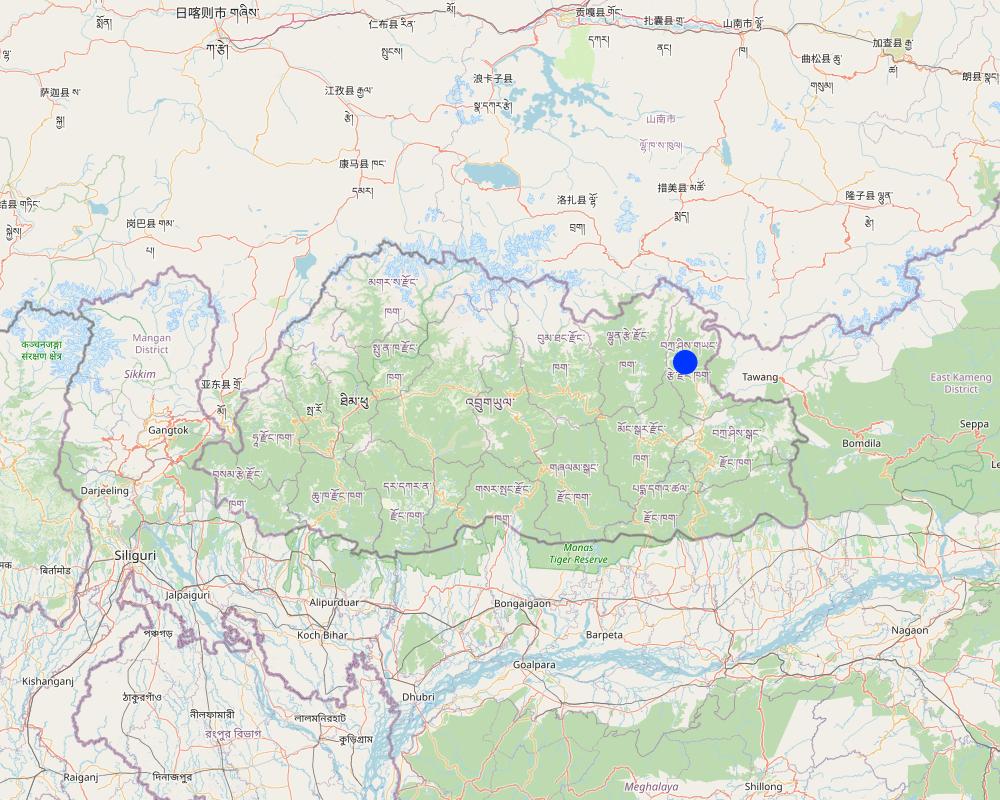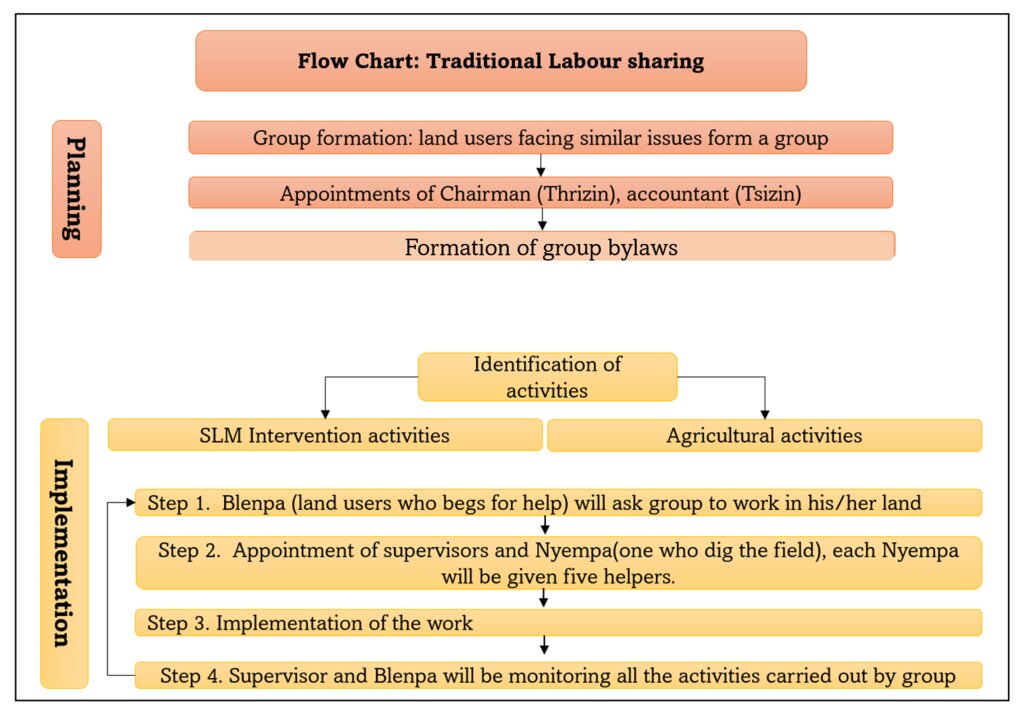Traditional labour sharing for farming [Bhoutan]
- Création :
- Mise à jour :
- Compilateur : ONGPO LEPCHA
- Rédacteur : Tashi Wangdi
- Examinateurs : William Critchley, Rima Mekdaschi Studer
Latsab
approaches_6894 - Bhoutan
Voir les sections
Développer tout Réduire tout1. Informations générales
1.2 Coordonnées des personnes-ressources et des institutions impliquées dans l'évaluation et la documentation de l'Approche
Personne(s) ressource(s) clé(s)
exploitant des terres:
Geduula
17324491
Namthurang wog, Betsamaang, Bumdeling, Trashi Yangtse District
Bhoutan
exploitant des terres:
Dema Karma
17328742
Namthurang wog, Betsamaang, Bumdeling, Trashi Yangtse District
Bhoutan
exploitant des terres:
Pelden Tshering
17371568
Namthurang wog, Betsamaang, Bumdeling, Trashi Yangtse District
Bhoutan
exploitant des terres:
Tshering Gonpo
17559260
Namthurang wog, Betsamaang, Bumdeling, Trashi Yangtse District
Bhoutan
exploitant des terres:
Wangmo Ugyen
17278903
Namthurang wog, Betsamaang, Bumdeling, Trashi Yangtse District
Bhoutan
exploitant des terres:
Karma
17363810
Namthurang wog, Betsamaang, Bumdeling, Trashi Yangtse District
Bhoutan
exploitant des terres:
Gurula
17718668
Namthurang wog, Betsamaang, Bumdeling, Trashi Yangtse District
Bhoutan
exploitant des terres:
Choden Karma
17781323
Namthurang wog, Betsamaang, Bumdeling, Trashi Yangtse District
Bhoutan
exploitant des terres:
Chozom Sither
17743907
Namthurang wog, Betsamaang, Bumdeling, Trashi Yangtse District
Bhoutan
exploitant des terres:
Gonpo Tshewang
17705121
Namthurang wog, Betsamaang, Bumdeling, Trashi Yangtse District
Bhoutan
Nom du projet qui a facilité la documentation/ l'évaluation de l'Approche (si pertinent)
Strengthening national-level institutional and professional capacities of country Parties towards enhanced UNCCD monitoring and reporting – GEF 7 EA Umbrella II (GEF 7 UNCCD Enabling Activities_Umbrella II)Nom du ou des institutions qui ont facilité la documentation/ l'évaluation de l'Approche (si pertinent)
National Soil Services Centre, Department of Agriculture, Ministry of Agriculture & Livestock (NSSC) - Bhoutan1.3 Conditions relatives à l'utilisation par WOCAT des données documentées
Quand les données ont-elles été compilées (sur le terrain)?
20/7/2023
Le compilateur et la(les) personne(s) ressource(s) acceptent les conditions relatives à l'utilisation par WOCAT des données documentées:
Oui
2. Description de l'Approche de GDT
2.1 Courte description de l'Approche
In the past, it was difficult for households to complete seasonal farming activities like ploughing, sowing, and transplanting in time. So, land users came together by adopting 'latsab' or labour sharing. This involves pooling land users, who work on a rotational basis on the plots of the different group members. Labour sharing is a very old approach but is still being practiced throughout the country.
2.2 Description détaillée de l'Approche
Description détaillée de l'Approche:
In the past, it was difficult for households to complete seasonal farming activities like ploughing, sowing, and transplanting in time. So, land users came together by adopting 'latsab' or labour sharing. This involves pooling land users, who work on a rotational basis on the plots of the different group members. Labour sharing is a very old approach but is still being practiced throughout the country. In addition, land users also come together for any construction work or other activities related to land management. Labour sharing aims to complete seasonal farming activities more efficiently and on time. The approach also helps economically disadvantaged land users who cannot pay wages to employ. Other co-benefits reported are the improved sense of community and enhanced social cohesion because the exchange of experiences and collaboration builds mutual trust. Working in a group eases hard physical work, such as carrying and breaking large boulders, and is perceived to be much more enjoyable than working alone or in a household setting.
Groups are formed at the village and sub-village levels to enable households to take up labour-intensive SLM activities, such as stone bunding, bench terracing, stone check dam construction, water source protection works, or grass hedgerow development. Labour-sharing involves land users coming together to discuss important agricultural activities to be implemented. They also select the land users where the work should start. When it comes to activities related to SLM intervention, the land users are given initial practical training on the SLM intervention, which starts with hands-on work on the land of a group member, preferably that of a vulnerable household. Labour-sharing groups, therefore, facilitate the inclusion of vulnerable households, especially female-headed and small families, in the implementation of labour-intensive SLM interventions. In addition to technical guidance provided by extension staff, support is given to the group formation process, such as drafting informal by-laws and group management.
Any activities through a labour-sharing approach have to undergo specific stages. Initially, the land users will come together to discuss important agricultural or SLM activities to be carried out in a season. Secondly, they identify a 'Blenpa' who is a land user who requests help on his/ her land. Once in the field before they start any activities a supervisor or 'la pon' is appointed. If work involves heavy digging, a 'Nyempa' (preferably a strong man) is appointed, and he will be assisted by four or five women. The labour-sharing group is formed through common interests among different land users in the community. The group members come together and plan and prepare by-laws. They appoint a chairman or 'Trizin', who is the overall manager of the group. The accountant/treasurer or 'Tsezin' is appointed to take care of the finances. Any conflict between land users is solved within the group.
2.3 Photos de l'approche
2.5 Pays/ région/ lieux où l'Approche a été appliquée
Pays:
Bhoutan
Région/ Etat/ Province:
Namthrang wog (sub village), Betsamaang(village), Bumdeling(region), Trashi Yangtse(Provience)
Map
×2.6 Dates de début et de fin de l'Approche
Si l'année précise est inconnue, indiquez approximativement quand l'Approche a démarré:
il y a plus de 50 ans (technologie traditionnelle)
Commentaires:
The exact date and year of initiation are not known as this approach has been practiced by their ancestors.
2.7 Type d'Approche
- traditionnel/ autochtone
2.8 Principaux objectifs de l'Approche
The main aims/objectives of the approach are 1) Labour-sharing to complete seasonal activities faster and on time, 2) To support economically disabled land users who cannot pay for hired workers, and 3) To share resources like water which is important for carrying out farming activities.
2.9 Conditions favorisant ou entravant la mise en œuvre de la(des) Technologie(s) appliquée(s) sous l'Approche
normes et valeurs sociales/ culturelles/ religieuses
- favorise
All land users involved are from same ethnic group. They shared common social, cultural, and religious, norms and values. Implementation of any SLM activities was seen as enabling.
disponibilité/ accès aux ressources et services financiers
- favorise
Land users were accessible to financial resources and services as most of them are either members of a vegetable group or a Chilli group. As a member, they are privileged to avail loans.
collaboration/ coordination des acteurs
- favorise
The group formation is democratic and the leader selected to regulate the group was selected by land users themselves. Therefore, strong collaboration is observed.
connaissances sur la GDT, accès aux supports techniques
- favorise
Land users are aware of SLM interventions like terracing, bunding, stone bunding, growing Napier grass, etc. These indicated that they have good knowledge and are accessible to technical support from SLM specialists.
marchés (pour acheter les intrants, vendre les produits) et prix
- favorise
Land users indicated that they have a good market for their produce like chilli and potatoes. They have a group that deals with marketing.
charge de travail, disponibilité de la main-d'œuvre
- favorise
Land users are happy that the current approach of labour-sharing helped them a lot when it comes to workload and labour shortage. Although if there are fewer household members, the approach helps them to carry out important agricultural activities in time.
3. Participation et rôles des parties prenantes impliquées dans l'Approche
3.1 Parties prenantes impliquées dans l'Approche et rôles
- exploitants locaux des terres / communautés locales
10 households were involved out of which 6 are females and 4 are male. They are mostly from the age group between 40-60 years old, All of them are married and are economically disabled. All of them belong to the same ethnic group known as
Land users are involved in the planning of by-laws, and implementation of activities, Elected chairman is responsible for the smooth functioning of the group. The accountant takes care of the finances. Any conflict between land users is solved within the group.
- Spécialistes de la GDT/ conseillers agricoles
Extension agent
He/she is not part of the group but is involved whenever he/she needs assistance from the group. He/she acts as an SLM specialist at the village level.
3.2 Participation des exploitants locaux des terres/ communautés locales aux différentes phases de l'Approche
| Participation des exploitants locaux des terres/ communautés locales | Spécifiez qui était impliqué et décrivez les activités | |
|---|---|---|
| initiation/ motivation | auto-mobilisation | The labour-sharing approach was initiated by the ancestors of current land users. Current land users found this approach as an effective way to mitigate labour shortage and resource management and they continue to preserve and practice it. |
| planification | auto-mobilisation | Land users are the ones who come together, prepare their by-laws and plan all the activities related to farming or SLM intervention. |
| mise en œuvre | auto-mobilisation | The approach has an elected chairman and accountant who are responsible for the smooth running of the group and finances. Any conflicts that arise between land users are solved within the group. |
| suivi/ évaluation | auto-mobilisation | The group is monitored by the chairman. During the time of any activities, they also appoint a supervisor who will monitor the quality of the work performed by the members. |
3.3 Diagramme/ organigramme (si disponible)
Description:
Flow chart created following conversation with the group. There are two important phases, initially planning which includes group formation, and by-law, and the second phase is the implementation phase.
Auteur:
Ongpo Lepcha
3.4 Prises de décision pour la sélection de la Technologie/ des Technologies
Indiquez qui a décidé de la sélection de la Technologie/ des Technologies à mettre en œuvre:
- principalement les exploitants des terres soutenus par des spécialistes de la GDT
Expliquez:
The technologies implemented by land users have been decided by land users and upon their request to the government the SLM specialist are sent and technology related training and materials are provided to the group.
4. Soutien technique, renforcement des capacités et gestion des connaissances
4.1 Renforcement des capacités/ formation
Une formation a-t-elle été dispensée aux exploitants des terres/ autres parties prenantes?
Oui
Spécifiez qui a été formé:
- exploitants des terres
Formats de la formation:
- zones de démonstration
Thèmes abordés:
Improved ways to dry Chilli, Nursery bed preparation, electric fencing, Growing Napier grass, Chainlink fencing, Greenhouse construction, etc.,
Commentaires:
The training was provided by extension agents
4.2 Service de conseils
Les exploitants des terres ont-ils accès à un service de conseils?
Oui
Décrivez/ commentez:
Whenever there is an outbreak of crops or livestock diseases, advisory services are provided by agricultural and livestock officers on do and don't of the issues.
4.3 Renforcement des institutions (développement organisationnel)
Des institutions ont elles été mises en place ou renforcées par le biais de l'Approche?
- oui, beaucoup
Spécifiez à quel(s) niveau(x), ces institutions ont été renforcées ou mises en place:
- local
Décrivez l'institution, ses rôles et responsabilités, ses membres, etc.
Within the labour-sharing group, land users also have formed other groups like the Chilli group (focusing on cultivating and marketing chilli), Vegetable group (involved in growing and marketing vegetables other than chilli)
Précisez le type de soutien:
- financier
- renforcement des capacités/ formation
- équipement
Donnez plus de détails:
The financial institution provides loans to those land users who are members of the group. Support from the government and external projects targeted to the groups. As a result, members of the group have received training in Chilli drying through the Tarayana Foundation. Members also shared that when they work in groups they also share tools, equipments, machinary, etc., which indirectly reduces the cost.
4.4 Suivi et évaluation
Le suivi et l'évaluation font ils partie de l'Approche? :
Oui
Commentaires:
Labour sharing involves working on a rotation basis. The group has a chairman who monitors the overall activities of the group. When it comes to agricultural or SLM intervention activities carried out at individual land user's fields. The supervisor is appointed who monitors and supervises the work.
Si oui, ce document est-il destiné à être utilisé pour le suivi et l'évaluation?
Non
4.5 Recherche
La recherche a-t-elle fait partie intégrante de l’Approche?
Non
5. Financement et soutien matériel externe
5.1 Budget annuel de la composante GDT de l'Approche
Commentez (par ex. principales sources de financement/ principaux bailleurs de fonds):
The group is mainly formed by those land users who are economically disabled. They work on a rotation basis so that they don't have to pay for human resources involved in carrying out any agricultural or SLM intervention activities.
5.2 Soutiens financiers/ matériels fournis aux exploitants des terres
Les exploitants des terres ont-ils reçu un soutien financier/ matériel pour la mise en œuvre de la Technologie/ des Technologies?
Oui
Si oui, spécifiez le(s) type(s) de soutien, les conditions et les fournisseurs:
Electric fencing: The materials were supported by the government.
Chilli dryer:
5.3 Subventions pour des intrants spécifiques (incluant la main d'œuvre)
- équipement
| Spécifiez les intrants subventionnés | Dans quelle mesure | Spécifiez les subventions |
|---|---|---|
| Chilli Dryer | entièrement financé | They received one dryer from the Women's Division under the National Commission for Women and Children (NCWC). |
- matériaux de construction
| Spécifiez les intrants subventionnés | Dans quelle mesure | Spécifiez les subventions |
|---|---|---|
| Electric fencing | entièrement financé | All the materials required for electric fencing were provided by the Bhutan government. |
- infrastructures
- autre
| Autre (spécifiez) | Dans quelle mesure | Spécifiez les subventions |
|---|---|---|
| Green house | en partie financé | The total cost for greenhouse materials was shared between individual land user and the government. 30% of the total cost is borne by land users and 70% by the government. |
Si la main d'œuvre fournie par les exploitants des terres était un intrant substantiel, elle était:
- récompensée avec un autre soutien matériel
Commentaires:
All materials required were supplied by the government for free. Land users were involved in construction/installation.
5.4 Crédits
Des crédits ont-ils été alloués à travers l'Approche pour les activités de GDT?
Non
5.5 Autres incitations ou instruments
D'autres incitations ou instruments ont-ils été utilisés pour promouvoir la mise en œuvre des Technologies de GDT?
Oui
Si oui, spécifiez:
The group also received a cake-making machine. However, this was shared among different groups from other places.
6. Analyses d'impact et conclusions
6.1 Impacts de l'Approche
Est-ce que l'Approche a autonomisé les exploitants locaux des terres, amélioré la participation des parties prenantes?
- Non
- Oui, un peu
- Oui, modérément
- Oui, beaucoup
Yes, the approach has empowered local land users. Gender equality is maintained and Chairmanship is done on a rotation basis. The work done by the group is supported by government and other external projects.
Est-ce que l'Approche a aidé les exploitants des terres à mettre en œuvre et entretenir les Technologies de GDT?
- Non
- Oui, un peu
- Oui, modérément
- Oui, beaucoup
The group is basically focused on agricultural activities and to protect their crop from wildlife they have installed electric fencing. They also rear dairy as a source of manure to improve the fertility of the soil.
Est-ce que l'Approche a amélioré les connaissances et les capacités des exploitants des terres pour mettre en œuvre la GDT?
- Non
- Oui, un peu
- Oui, modérément
- Oui, beaucoup
Government and external support is directed to the group because it is quite cheaper than providing to individual land users. Any kind of capacity development related to agricultural activities or SLM intervention is given to the group. Group members also shared that they received training in various fields of SLM like stone bunding, Terracing, Electric fencing, greenhouse construction, and improved dairy shed construction.
Est-ce que l'Approche a atténué les conflits?
- Non
- Oui, un peu
- Oui, modérément
- Oui, beaucoup
Establishment of the electric fencing solved human-wildlife conflicts. Irrigation water used to be an important issue for conflict in the past. However, group formation has helped the community improve their irrigation by improving source and also scheduling irrigation timing among the members.
Est-ce que l'Approche a autonomisé les groupes socialement et économiquement défavorisés?
- Non
- Oui, un peu
- Oui, modérément
- Oui, beaucoup
The group consists of members who are economically disabled. The group has helped them to sustain their livelihood as any agricultural activities are carried out in time. The members also don't have to pay for labours which otherwise is very expensive. Working together also builds a sense of belongingness and closeness among the members.
Est-ce que l'Approche a amélioré l'accès aux marchés?
- Non
- Oui, un peu
- Oui, modérément
- Oui, beaucoup
The members of the Labour-sharing group are also members of other groups like the Chilli and Vegetable group. This has helped them to market their produce.
6.2 Principale motivation des exploitants des terres pour mettre en œuvre la GDT
- augmenter la production
Every agricultural activity carried out by the group is monitored thus improving the conditions in which a crop grows, thus increasing production.
- augmenter la rentabilité/ bénéfice, rapport coûts-bénéfices
Members of the group work on a rotation basis thus reducing production costs and increasing the cost-benefit ratio.
- réduire la dégradation des terres
Agricultural activities are done manually thus reducing land degradation.
- réduire les risques de catastrophe
Agricultural activities are seasonal and every activity has to be done in time. Labor-sharing groups helped members to complete these activities in time thus reducing the risk of disaster.
- réduire la charge de travail
Group members come together and work for a common goal thus reducing workload.
- atténuer les conflits
Member shared that conflict that arises due to irrigation water is no more.
6.3 Durabilité des activités de l'Approche
Les exploitants des terres peuvent-ils poursuivre ce qui a été mis en œuvre par le biais de l'Approche (sans soutien extérieur)?
- incertain
Si non ou incertain, spécifiez et commentez:
The approach was there in the past when external support was not there. It is continuing today, but it is uncertain whether this approach will survive in the future with changing climate and improving the lifestyle of every farmer.
6.4 Points forts/ avantages de l'Approche
| Points forts/ avantages/ possibilités du point de vue de l'exploitant des terres |
|---|
| The approach allows members to enhance social cohesion and community sense. They come together for any kind of work, thus tackling the main issue of labour shortage and easing hard physical work. |
| Agricultural activities like ploughing, tilling, sowing, transplanting, weeding, watering, and harvesting, have to be completed on time. The approach allows every member to complete these activities on time avoiding crop failure and enhancing crop production. |
| The approach includes all vulnerable groups giving them opportunities to share their problems and supporting them through labour-sharing to carry out important agricultural activities for crop production. |
| Points forts/ avantages/ possibilités du point de vue du compilateur ou d'une autre personne ressource clé |
|---|
| The approach demands equal participation from all household members. Thus giving training on any SLM intervention activities by SLM experts becomes very easy. It is also easy to communicate to the group for dissemination of any information. |
| The approach helps the economically disabled members to sustain their livelihood. This is because labour-sharing cut many of the costs involved in crop production or SLM intervention activities increasing the cost-benefit ratio. |
6.5 Faiblesses/ inconvénients de l'Approche et moyens de les surmonter
| Faiblesses/ inconvénients/ risques du point de vue de l’exploitant des terres | Comment peuvent-ils être surmontés? |
|---|---|
| Marketing of agricultural produce: There are many other groups at the village and sub-district level. They compete to capture the local market which is always saturated with supply. Exploring the market at the domestic and international levels is very expensive for the majority of the group. | The government takes some initiative to explore the market for these groups or give them some incentives to do marketing like marketing van. |
| Faiblesses/ inconvénients/ risques du point de vue du compilateur ou d'une autre personne ressource clé | Comment peuvent-ils être surmontés? |
|---|---|
| The sustainability of the group: Most of the members are between the age group of 40-70. The young generation is not interested in agriculture and in the future, there are chances that this kind of group may die. | The government must take some initiative to make our young generation like Agriculture by bringing new technologies that will ease hard human labour. |
7. Références et liens
7.1 Méthodes/ sources d'information
- visites de terrain, enquêtes sur le terrain
Three sites were visited to see the group working.
- interviews/entretiens avec les exploitants des terres
10 land users representing 10 households were interviewed.
- compilation à partir de rapports et d'autres documents existants
5
7.2 Références des publications disponibles
Titre, auteur, année, ISBN:
BHUCAT (Bhutan catalogue of soil and water conservation approaches and technologies):Best practices and guidelines from Bhutan for sustainable land managements on steep to very steep slopes, National Soil Service Center, Department of Agriculture, Ministry of Agriculture and Forest 2012,
Disponible à partir d'où? Coût?
A copy of a book was provided by National Soil Service Center, Simtokha: Bhutan for Free.
Titre, auteur, année, ISBN:
2021 Labour force survey report Bhutan, National statistics Bureau, 2021, ISBN 978-99936-28-93-4
Disponible à partir d'où? Coût?
available online for free. https://www.nsb.gov.bt/wp-content/uploads/dlm_uploads/2022/04/LFS-2021-web.pdf
7.3 Liens vers les informations pertinentes disponibles en ligne
Titre/ description:
SLM Labour-sharing group Bhutan
URL:
https://qcat.wocat.net/wocat/approaches/view/approaches_2491/
Titre/ description:
Sharing labour to implement contour bunding in Nepal
URL:
https://qcat.wocat.net/wocat/approaches/view/approaches_2604/
Titre/ description:
Organic agriculture, Labour exchange, and social networks: a case study of smallholder farming in Bhutan
URL:
https://link.springer.com/article/10.1007/s13165-022-00416-z
Liens et modules
Développer tout Réduire toutLiens
Aucun lien
Modules
Aucun module trouvé


